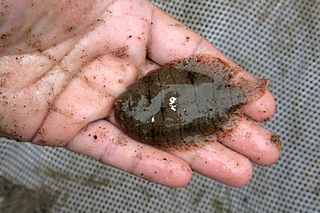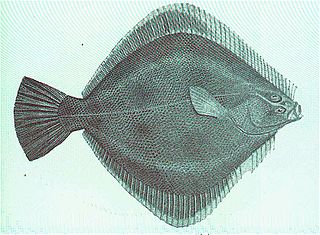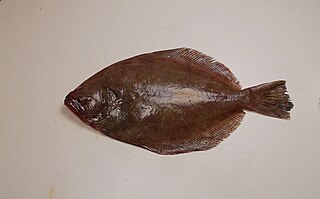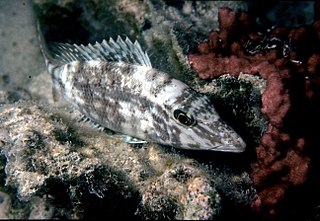
The zebra shark is a species of carpet shark and the sole member of the family Stegostomatidae. It is found throughout the tropical Indo-Pacific, frequenting coral reefs and sandy flats to a depth of 62 m (203 ft). Adult zebra sharks are distinctive in appearance, with five longitudinal ridges on a cylindrical body, a low caudal fin comprising nearly half the total length, and usually a pattern of dark spots on a pale background. Young zebra sharks under 50–90 cm (20–35 in) long have a completely different pattern, consisting of light vertical stripes on a brown background, and lack the ridges. This species attains a length of 2.5 m (8.2 ft).

The hogchoker is a small flatfish found along the Atlantic coast of North America, ranging from Massachusetts and Florida to Panama. They prefer brackish water, and are abundant in many bays and estuaries north of the Carolinas. It is a member of the American sole family Achiridae. They are usually brown to dark brown in color, and lighter on their "blind side". The overall body color is often broken by a series of spots and thin stripes, which can be lighter or darker than the main body color. The fins and tail have fringed edges helping hide the fish from its prey. They mainly feed on small aquatic insects and invertebrates. They are regarded as "trash fish" by recreational fishermen and were fed to pigs but they have rather bony bodies which were sometimes difficult for the pigs to swallow, hence the vernacular name.

The common dab is an edible flatfish of the family Pleuronectidae. It is a demersal fish native to shallow seas around Northern Europe, in particular the North Sea, where it lives on sandy bottoms down to depths of about 100 metres (330 ft). It can reach 40 centimetres (16 in) in length and can weigh up to 1 kilogram (2.2 lb), though most specimens grow no longer than 20 centimetres (7.9 in).

The starry flounder, also known as the grindstone, emery wheel and long-nosed flounder, is a common flatfish found around the margins of the North Pacific.

The New Zealand sand flounder is a righteye flounder of the genus Rhombosolea, found around New Zealand in shallow waters down to depths of 100 m.
The speckled swellshark is a little-known species of catshark, and part of the family Scyliorhinidae, endemic to the waters off northwestern Australia. It occurs on the outer continental shelf and upper continental slope, at a depth of 150–455 m (492–1,493 ft). This species grows to 69 cm (27 in) long and has a stocky body and a short, broad, flattened head. As its common name suggests, its color pattern consists of many dark spots and white-spotted dark saddles and blotches on a light gray background. The juveniles are yellow with dark spots and lines, and a distinctive eyespot-like mark behind each eye. Like other swellsharks, this species can inflate itself as a defensive measure.

The European flounder is a flatfish of European coastal waters from the White Sea in the north to the Mediterranean and the Black Sea in the south. It has been introduced into the United States and Canada accidentally through transport in ballast water. It is caught and used for human consumption.

The summer flounder or fluke is a marine flatfish that is found in the Atlantic Ocean off the East Coast of the United States and Canada. It is especially abundant in waters from North Carolina to Massachusetts.

The plate fish is a flounder in the genus Bothus, found in the warmer parts of the Atlantic including the Caribbean. Its typical habitat is sandy plains near coral reefs and it is able to change its colouring to make it well-camouflaged in this environment. It is sometimes known as the peacock flounder, a name also given to the closely related Bothus mancus from the Indo-Pacific.

Paralichthys lethostigma, the southern flounder, is a species of large-tooth flounder native to the East Coast of the United States and the northern Gulf of Mexico. It is a popular sport fish and is the largest and most commercially valuable flounder in the western North Atlantic Ocean and Gulf of Mexico. It is a "left-eyed flounder", meaning the left side is pigmented and is the "up side".

The Pacific sand sole, also known as simply sand sole, is a flatfish species inhabiting the northeastern Pacific waters where it lives on sandy bottoms. The only species in the genus, Psettichthys, it ranges from the Bering Sea to Northern California.

Hippoglossina oblonga, is a flatfish and member of the large-tooth flounder family Paralichthyidae. This species has been placed in the genus Paralichthys by some authorities.

Coastal fish, also called inshore fish or neritic fish, inhabit the sea between the shoreline and the edge of the continental shelf. Since the continental shelf is usually less than 200 metres (660 ft) deep, it follows that pelagic coastal fish are generally epipelagic fish, inhabiting the sunlit epipelagic zone. Coastal fish can be contrasted with oceanic fish or offshore fish, which inhabit the deep seas beyond the continental shelves.

The peacock flounder, also known as the flowery flounder, is a species of fish in the family Bothidae. The species is found widely in relatively shallow waters in the Indo-Pacific, also ranging into warmer parts of the east Pacific.

Bothus is a genus of flatfish in the family Bothidae from the Pacific, Indian and Atlantic Oceans. Some species in this genus have spots consisting of blue rings.

Lethrinus olivaceus, common name longface emperor or long-nosed emperor, is a species of bony fishes belonging to the family Lethrinidae.

Lethrinus microdon is a species of emperor fish. It is a marine fish, bluish-grey or brown in colour with pale or somewhat orange fins. This species is reef-associated and is often found in small schools, occasionally with Lethrinus olivaceus at depths of 10 to 80 metres. It is widespread in the Indo-West Pacific and other waters. This species is caught commercially and is considered to be an excellent food fish.

The eyed flounder is a species of fish in the family Bothidae. The species is found on or near the sandy seabed in relatively shallow waters in the western Atlantic Ocean, the Caribbean Sea and the Gulf of Mexico.

Bothus podas, also known as the wide-eyed flounder, is a flounder in the genus Bothus, native to the Mediterranean Sea and the Atlantic Coast of Africa.
Arnoglossus imperialis, the imperial scaldfish, is a species of flatfish from the family of left-eyed flounders, the Bothidae. It occurs in the eastern Atlantic from Scotland south to Namibia, extending into the western Mediterranean. This bottom dwelling species is sometimes caught as bycatch but is of little interest to fisheries.




















